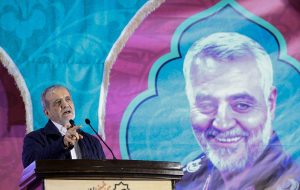We will continue Soleimani’s path: Pezeshkian
TEHRAN – The southeastern city of Kerman is an unlikely destination for travelers in winter. Its desert surroundings make its climate susceptible to drastic temperature fluctuations, and the nearby sand dunes often obscure the air. The potential for sudden cold snaps is another deterrent that typically keeps visitors away during the colder months. Yet, on


TEHRAN – The southeastern city of Kerman is an unlikely destination for travelers in winter. Its desert surroundings make its climate susceptible to drastic temperature fluctuations, and the nearby sand dunes often obscure the air. The potential for sudden cold snaps is another deterrent that typically keeps visitors away during the colder months. Yet, on Thursday, the city was bustling with millions of travelers from all corners of Iran.
This annual influx has been a consistent pattern for the past few years. Despite the city being crowded, people of all backgrounds – young and old, Muslims and non-Muslims, and even many foreign visitors – are resolute in making their way to Kerman. Last year’s devastating terrorist attack, which claimed over 100 lives, should have further discouraged travel, but the visitors seem focused solely on reaching the tomb of the individual they believe embodies their security and assurance.
“I feel it’s my duty to be here,” said a woman who had traveled with her two daughters from Iran’s northwestern East Azarbaijan Province. “When I reflect on what Haj Qassem did for us, what I do in return feels inadequate.”
Haj Qassem is a popular term of reference for Lieutenant General Qassem Soleimani, the long-time commander of the Quds Force of the Islamic Revolution Guard Corps (IRGC), who was assassinated in a U.S. drone strike in Baghdad on January 3, 2020.
Why is General Soleimani significant?
For ordinary Iranians, General Qassem Soleimani is remembered as a key figure in preventing the incursion and potential occupation of their country by ISIS (Daesh). The terrorist group, notorious for its brutality, including the routine beheading of civilians which it proudly displayed on social media, had seized large territories in Iraq and Syria during the 2010s, posing a grave threat to the entire region.
Though General Soleimani avoided the spotlight and rarely appeared before cameras, the millions who attended his funeral in 2020 reflected the profound respect he commanded. He was revered, not for his military rank, but for his contributions to the nation’s safety and security. General Soleimani’s commitment to his country began at the age of 20, when he joined the forces resisting Iraqi dictator Saddam Hussein’s invasion of Iran in the 1980s. His fight for Iran ended only when he lost his life in an unprecedented and illegal U.S. attack.
For those observing global power dynamics, General Soleimani is also seen as someone who galvanized resistance movements throughout the region. His influence united diverse groups in West Asia under the banner of the “Axis of Resistance,” a network of forces engaged in the fight against Western imperialism, foreign intervention, and Israeli occupation.
At a large ceremony in Tehran commemorating General Soleimani, President Masoud Pezeshkian declared, “We pledge to continue Martyr Soleimani’s path with strength and stand against injustice as long as we live. We will stand for the truth, showing our strength to those who would oppress us.” He noted that General Soleimani’s martyrdom exposed the hypocrisy of Western powers and their claims regarding human rights. “Such a person was martyred,” he added, “and showed that those claiming to support humanity and human rights are, in fact, liars. They are enemies of humanity who reveal their barbarism and crimes.”
In a significantly smaller gathering in Qanat-e Malek village, General Soleimani’s humble birthplace, a similar spirit was evident. “Haj Qassem’s martyrdom marks not an end, but a beginning,” said a local resident whose family had lived in the village for generations. “Our fight has only begun.”
